Dual-Band Circularly Polarized Hybrid Dielectric Resonator Antenna for 5G Millimeter-Wave Applications
Abstract
:1. Introduction
2. Antenna Design
2.1. Antenna Configuration
2.2. Evolution of the Design
3. Working Mechanism
4. Parametric Study
5. Results and Discussion
| Ref. No. | * Overlapping Bandwidth @ Center Frequency | Peak Gain (dBic) | Independently Designed | Wideband CP Technology |
|---|---|---|---|---|
| [17] | 10.17% @ 59 GHz | 10.35 | - | Hybrid of patch antenna and DRA |
| [18] | 15.9% @ 59.75 GHz | 11.43 | - | Sequential rotation feeding array |
| [19] | 26.3% @ 23.4 GHz | 8.15 | - | Modified structure of cylindrical DRA |
| [20] | 12.8% @ 22.7 GHz 5% @ 28.1 GHz | LB 1: 5 UB 2: 8 | No | Modified structure of rectangular DRA |
| Proposed work | 19.8% @ 27.5 GHz 7.8% @ 41.5 GHz | LB: 5.62 UB: 6.74 | Yes | Hybrid of slot antenna and DRA |
6. Conclusions
Author Contributions
Funding
Conflicts of Interest
References
- Rappaport, T.S.; Sun, S.; Mayzus, R.; Zhao, H.; Azar, Y.; Wang, K.; Wong, G.; Schulz, J.K.; Samimi, M.; Gutierrez, F. Millimeter wave mobile communications for 5G cellular: It will work! IEEE Access 2013, 1, 335–349. [Google Scholar] [CrossRef]
- Lee, J.; Tejedor, E.; Ranta-Aho, K.; Wang, H.; Lee, K.-T.; Semaan, E.; Mohyeldin, E.; Song, J.; Bergljung, C.; Jung, S. Spectrum for 5G: Global status, challenges, and enabling technologies. IEEE Commun. Mag. 2018, 56, 12–18. [Google Scholar] [CrossRef]
- Qiu, H.; Liu, H.; Jia, X.; Jiang, Z.-Y.; Liu, Y.-H.; Xu, J.; Lu, T.; Shao, M.; Ren, T.-L.; Chen, K.J. Compact, flexible, and transparent antennas based on embedded metallic mesh for wearable devices in 5G wireless network. IEEE Trans. Antennas Propag. 2021, 69, 1864–1873. [Google Scholar] [CrossRef]
- Jilani, S.F.; Alomainy, A. A multiband millimeter-wave 2-D array based on enhanced franklin antenna for 5G wireless systems. IEEE Antennas Wirel. Propag. Lett. 2017, 16, 2983–2986. [Google Scholar] [CrossRef]
- Pan, Y.M.; Qin, X.; Sun, Y.X.; Zheng, S.Y. A simple decoupling method for 5G millimeter-wave MIMO dielectric resonator antennas. IEEE Trans. Antennas Propag. 2019, 67, 2224–2234. [Google Scholar] [CrossRef]
- Zhang, Y.; Deng, J.-Y.; Li, M.-J.; Sun, D.; Guo, L.-X. A MIMO dielectric resonator antenna with improved isolation for 5G mm-wave applications. IEEE Antennas Wirel. Propag. Lett. 2019, 18, 747–751. [Google Scholar] [CrossRef]
- Bahreini, B.; Oraizi, H.; Noori, N.; Fakhte, S. Design of a circularly polarized parasitic array with slot-coupled DRA with improved gain for the 5G mobile system. IEEE Antennas Wirel. Propag. Lett. 2018, 17, 1802–1806. [Google Scholar] [CrossRef]
- Al-Hasan, M.J.; Denidni, T.A.; Sebak, A.R. Millimeter-wave EBG-based aperture-coupled dielectric resonator antenna. IEEE Trans. Antennas Propag. 2013, 61, 4354–4357. [Google Scholar] [CrossRef]
- Baldazzi, E.; Al-Rawi, A.; Cicchetti, R.; Smolders, A.B.; Testa, O.; van Coevorden Moreno, C.D.J.; Caratelli, D. A high-gain dielectric resonator antenna with plastic-based conical horn for millimeter-wave applications. IEEE Antennas Wirel. Propag. Lett. 2020, 19, 949–953. [Google Scholar] [CrossRef]
- Gong, K.; Hu, X.H. Low-profile substrate integrated dielectric resonator antenna implemented with PCB process. IEEE Antennas Wirel. Propag. Lett. 2014, 13, 1023–1026. [Google Scholar] [CrossRef]
- Al-Alem, Y.; Kishk, A.A. Wideband millimeter-wave dielectric resonator antenna with gain enhancement. IEEE Antennas Wirel. Propag. Lett. 2019, 18, 2711–2715. [Google Scholar] [CrossRef]
- Chen, Z.; Shen, C.; Liu, H.; Ye, X.; Qi, L.; Yao, Y.; Yu, J.; Chen, X. Millimeter-wave rectangular dielectric resonator antenna array with enlarged DRA dimensions, wideband capability, and high-gain performance. IEEE Trans. Antennas Propag. 2020, 68, 3271–3276. [Google Scholar] [CrossRef]
- Girjashankar, P.R.; Upadhyaya, T. Substrate integrated waveguide fed dual band quad-elements rectangular dielectric resonator MIMO antenna for millimeter wave 5G wireless communication systems. AEU Int. J. Electron. Commun. 2021, 137, 153821. [Google Scholar] [CrossRef]
- Anab, M.; Khattak, M.I.; Owais, S.M.; Khattak, A.A.; Sultan, A. Design and analysis of millimeter wave dielectric resonator antenna for 5G wireless communication systems. Prog. Electromagn. Res. C 2020, 98, 239–255. [Google Scholar] [CrossRef] [Green Version]
- Zhou, Y.; Jiao, Y.; Weng, Z.; Ni, T. A novel single-fed wide dual-band circularly polarized dielectric resonator antenna. IEEE Antennas Wirel. Propag. Lett. 2016, 15, 930–933. [Google Scholar] [CrossRef]
- Gupta, A.; Gangwar, R.K. Dual-band circularly polarized aperture coupled rectangular dielectric resonator antenna for wireless applications. IEEE Access 2018, 6, 11388–11396. [Google Scholar] [CrossRef]
- Perron, A.; Denidni, T.A.; Sebak, A.R. Circularly polarized microstrip/elliptical dielectric ring resonator antenna for millimeter-wave applications. IEEE Antennas Wirel. Propag. Lett. 2010, 9, 783–786. [Google Scholar] [CrossRef]
- Sun, Y.-X.; Leung, K.W. Circularly polarized substrate-integrated cylindrical dielectric resonator antenna array for 60 GHz applications. IEEE Antennas Wirel. Propag. Lett. 2018, 17, 1401–1405. [Google Scholar] [CrossRef]
- Yang, M.; Pan, Y.; Sun, Y.; Leung, K. Wideband circularly polarized substrate-integrated embedded dielectric resonator antenna for millimeter-wave applications. IEEE Trans. Antennas Propag. 2020, 68, 1145–1150. [Google Scholar] [CrossRef]
- Liu, Y.; Jiao, Y.; Weng, Z.; Zhang, C.; Chen, G. A novel millimeter-wave dual-band circularly polarized dielectric resonator antenna. Int. J. RF Microw. Comput. Aided Eng. 2019, 29, e21871. [Google Scholar] [CrossRef]
- Zahra, H.; Awan, W.A.; Ali, W.A.E.; Hussain, N.; Abbas, S.M.; Mukhopadhyay, S. A 28 GHz broadband helical inspired end-fire antenna and its MIMO configuration for 5G pattern diversity applications. Electronics 2021, 10, 405. [Google Scholar] [CrossRef]
- Zou, M.; Pan, J. Wideband hybrid circularly polarised rectangular dielectric resonator antenna excited by modified cross-slot. Electron. Lett. 2014, 50, 1123–1124. [Google Scholar] [CrossRef]
- Petosa, A. Dielectric Resonator Antenna Handbook; Artech House Antennas and Propagation Library: Boston, MA, USA, 2007. [Google Scholar]
- Mongia, R.K. Theoretical and experimental resonant frequencies of rectangular dielectric resonators. IEE Proc. H Microw. Antennas Propag. 1992, 139, 98–104. [Google Scholar] [CrossRef]
- Buerkle, A.; Sarabandi, K.; Mosallaei, H. Compact slot and dielectric resonator antenna with dual-resonance, broadband characteristics. IEEE Trans. Antennas Propag. 2005, 53, 1020–1027. [Google Scholar] [CrossRef] [Green Version]
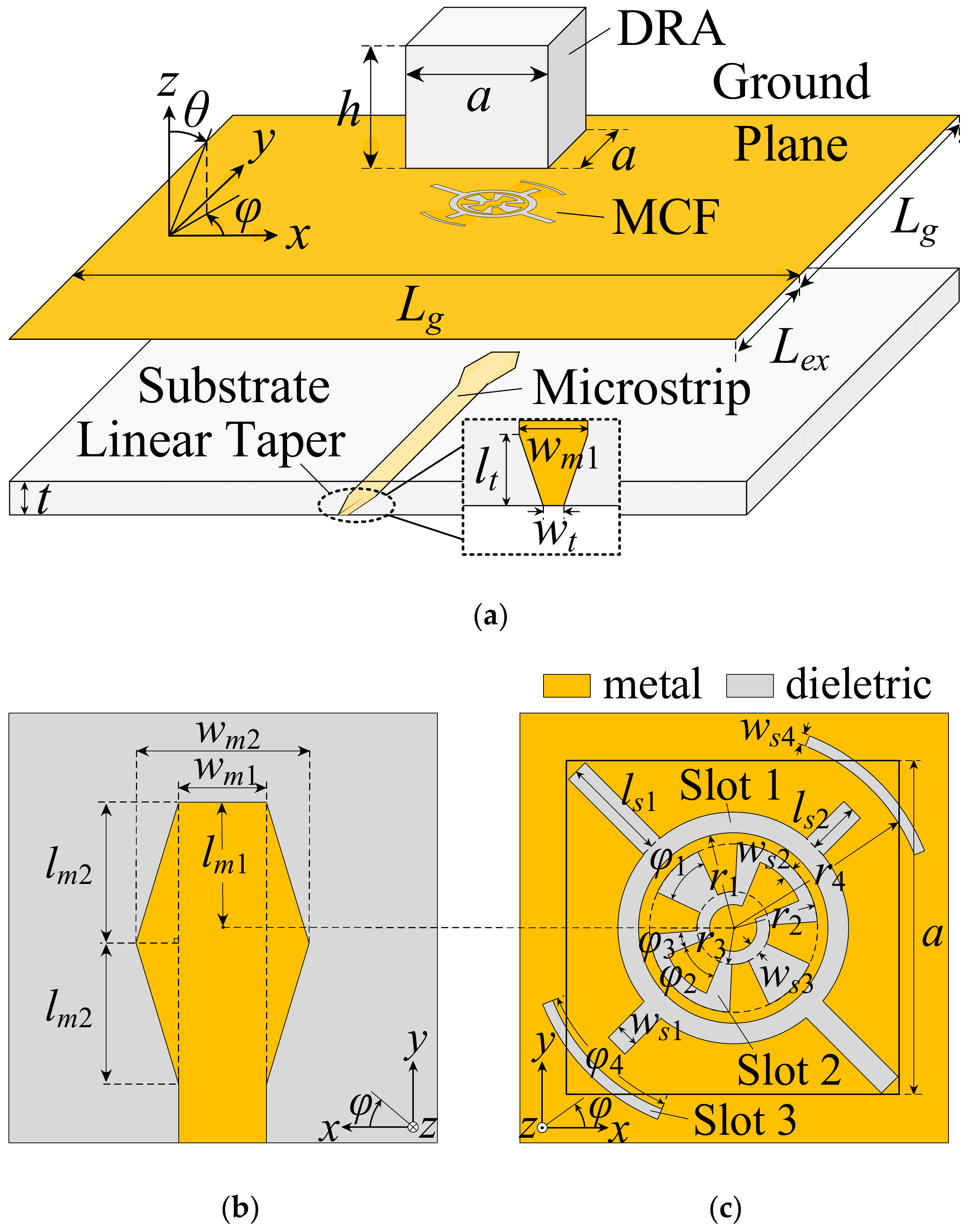

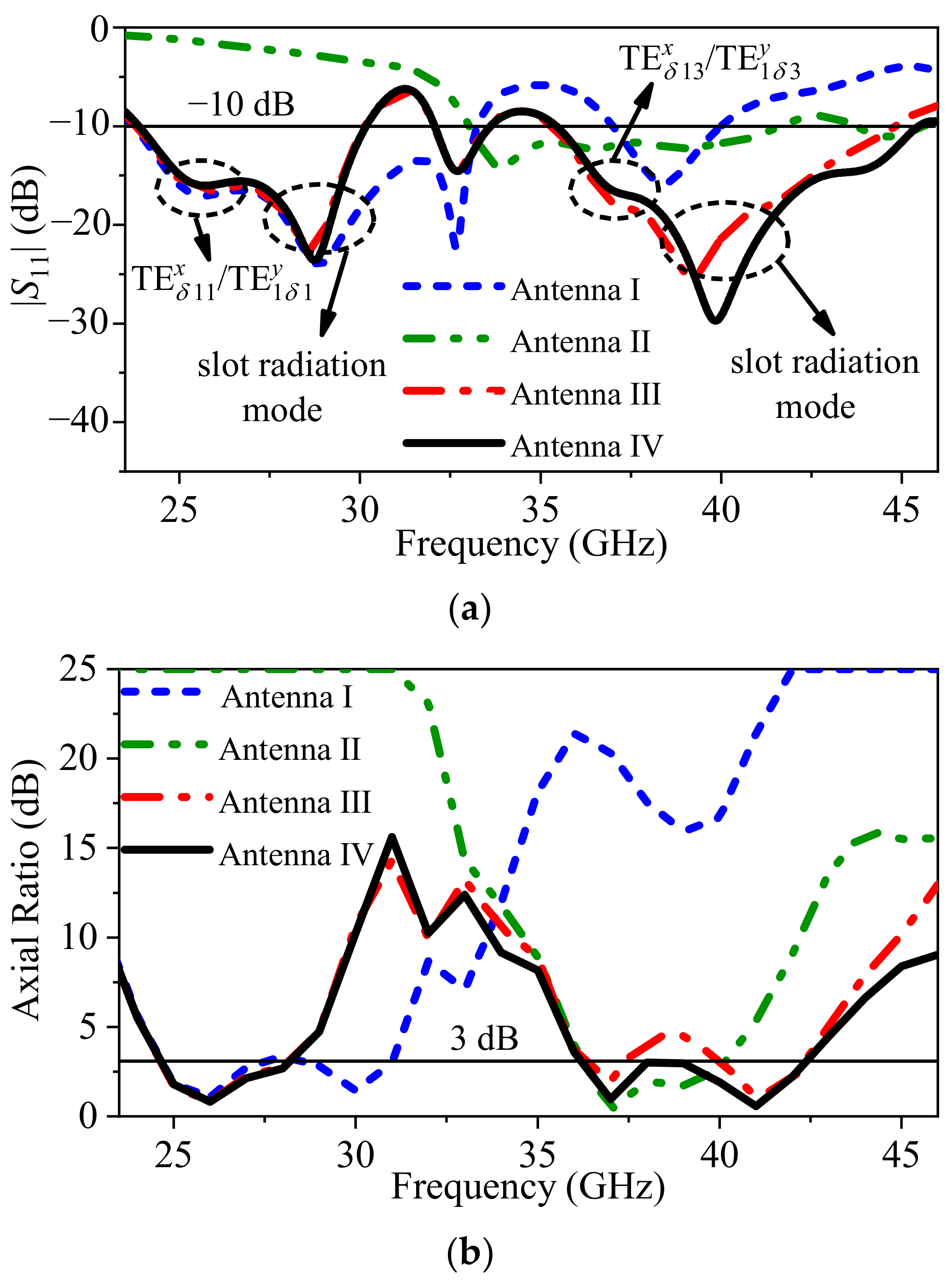



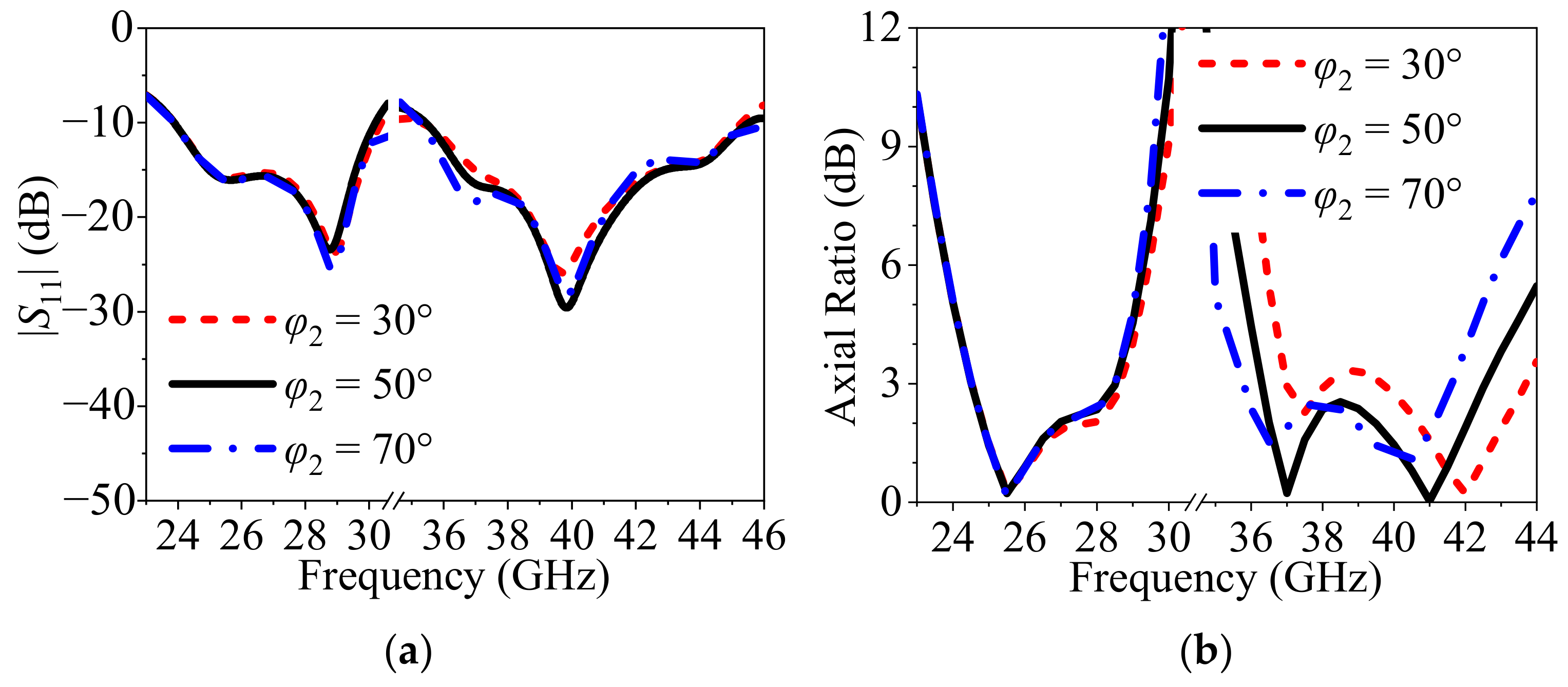




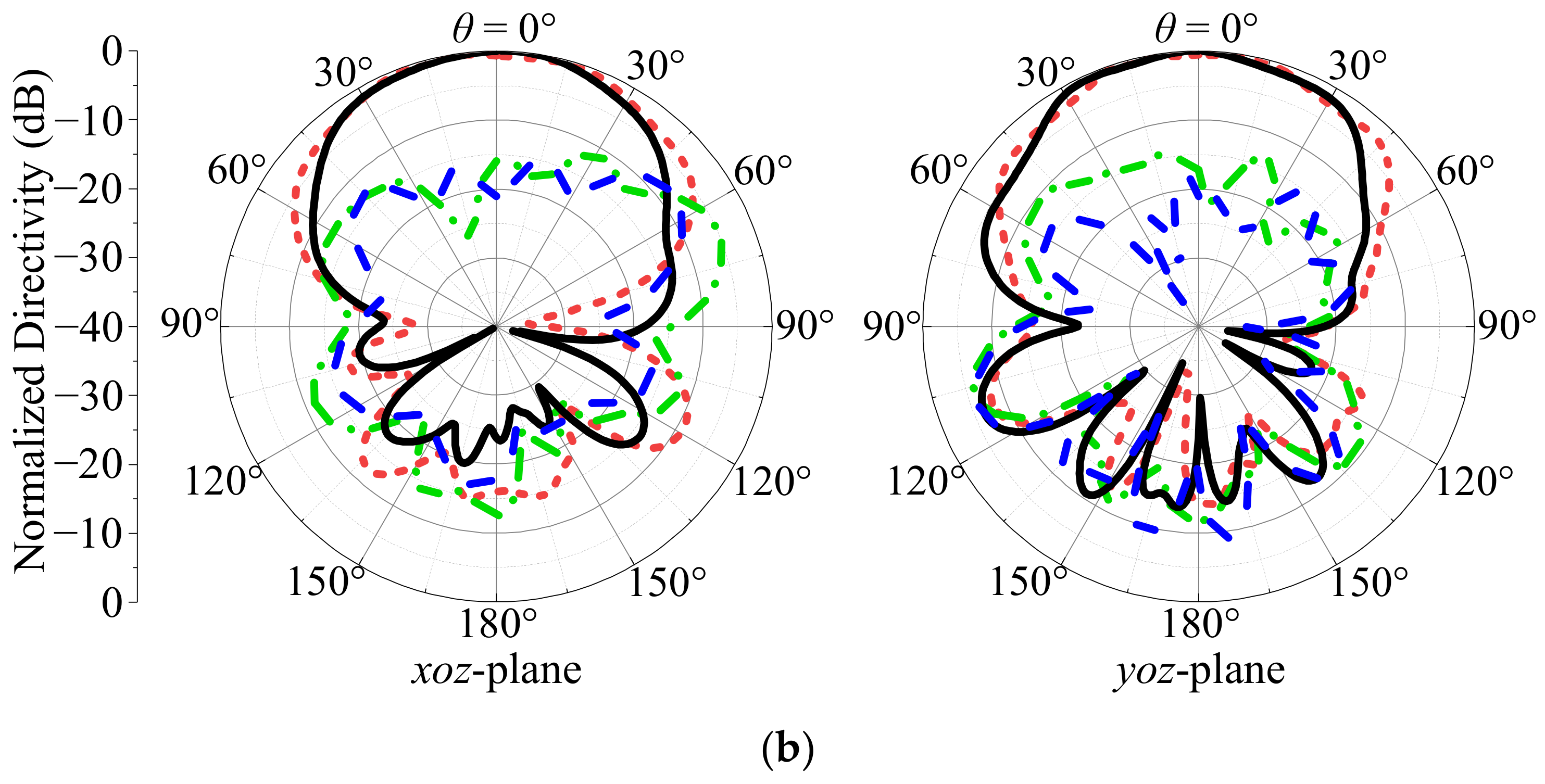
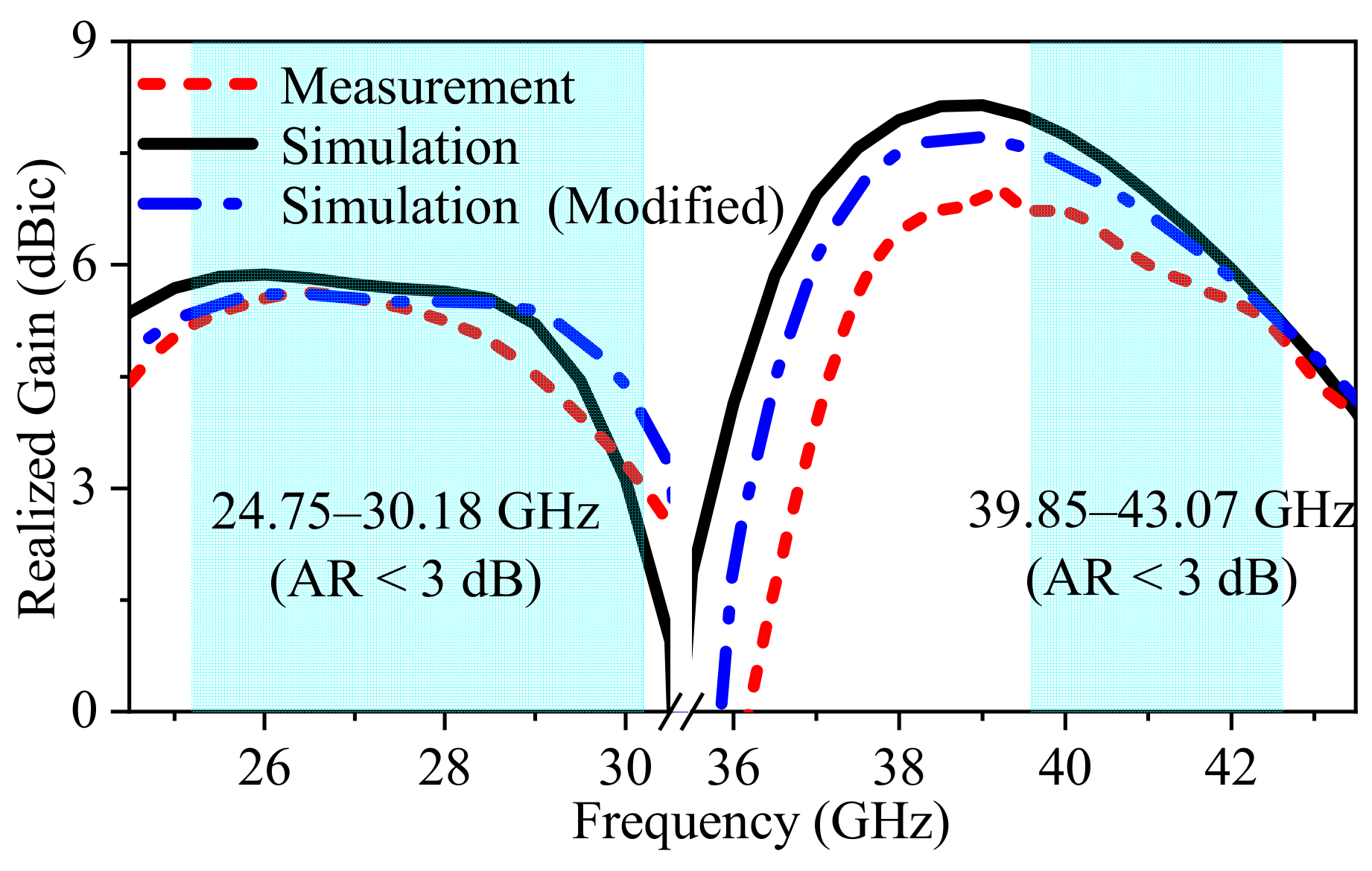
| Parameters | Values | Parameters | Values | Parameters | Values |
|---|---|---|---|---|---|
| a | 2.6 mm | h | 3 mm | t | 0.254 mm |
| Lex | 5 mm | Lg | 30 mm | wm1 | 0.74 mm |
| wm2 | 1.34 mm | lm1 | 1 mm | lm2 | 1.2 mm |
| φ1 | 50° | φ2 | 50° | φ3 | 15° |
| φ4 | 65° | ls1 | 0.9 mm | ls2 | 0.15 mm |
| ws1 | 0.2 mm | ws2 | 0.05 mm | ws3 | 0.1 mm |
| ws4 | 0.1 mm | r1 | 0.7 mm | r2 | 0.6 mm |
| r3 | 0.25 mm | r4 | 1.35 mm | wt | 0.49 mm |
| lt | 0.6 mm | ||||
Publisher’s Note: MDPI stays neutral with regard to jurisdictional claims in published maps and institutional affiliations. |
© 2022 by the authors. Licensee MDPI, Basel, Switzerland. This article is an open access article distributed under the terms and conditions of the Creative Commons Attribution (CC BY) license (https://creativecommons.org/licenses/by/4.0/).
Share and Cite
Huang, R.-Z.; Zhang, J.-W.; Zhang, C. Dual-Band Circularly Polarized Hybrid Dielectric Resonator Antenna for 5G Millimeter-Wave Applications. Electronics 2022, 11, 1761. https://doi.org/10.3390/electronics11111761
Huang R-Z, Zhang J-W, Zhang C. Dual-Band Circularly Polarized Hybrid Dielectric Resonator Antenna for 5G Millimeter-Wave Applications. Electronics. 2022; 11(11):1761. https://doi.org/10.3390/electronics11111761
Chicago/Turabian StyleHuang, Run-Ze, Jing-Wei Zhang, and Cheng Zhang. 2022. "Dual-Band Circularly Polarized Hybrid Dielectric Resonator Antenna for 5G Millimeter-Wave Applications" Electronics 11, no. 11: 1761. https://doi.org/10.3390/electronics11111761
APA StyleHuang, R.-Z., Zhang, J.-W., & Zhang, C. (2022). Dual-Band Circularly Polarized Hybrid Dielectric Resonator Antenna for 5G Millimeter-Wave Applications. Electronics, 11(11), 1761. https://doi.org/10.3390/electronics11111761








